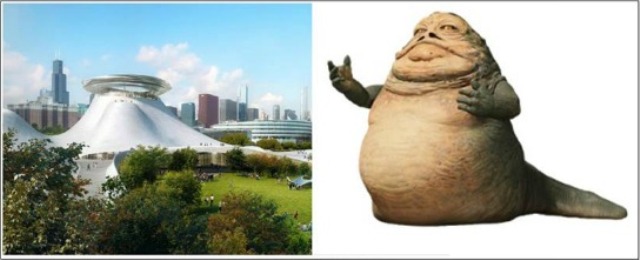Blair Kamin Nails The Lucas Museum Design Backlash
By Chuck Sudo in News on Nov 11, 2014 7:15PM

Update: This post has been corrected from its original version to reflect that Blair Kamin did indeed note the arguments about protecting the lakefront. We regret the error.
Judging from the online response, last week’s look at Ma Yansong’s design for the Lucas Museum of Narrative Art leaned heavily toward “for the love of all that’s holy, don’t build that on the lakefront!” Ma’s design doesn’t “rise up from the land” as much as it looks plopped between Soldier Field and McCormick Place, as though George Lucas himself decided to add unnecessary digital characters and scenes to his original Star Wars trilogy; this was more Asian carp invasion than breathtaking marvel that would complement Chicago’s architectural history.
Tribune architectural critic Blair Kamin agrees and calls the mountainous Lucas Museum design “jarringly off-key” with the existing lakefront landscape. “People are mad because they instinctively get that this cartoonish mountain of a building would be glaringly out of place amid the horizontal sweep of Chicago's lakefront,” Kamin writes.
We couldn’t have written it better. Kamin argues Ma's bloated design is fundamentally the fault of Lucas and the museum. He also recognized the main issue opponents have grasped about the Lucas Museum almost immediately: this is a vanity project earmarked for placement on the Lake Michigan shoreline, Chicago’s most sacred of public spaces.
Plunk down Ma's mountain and you have an imposing row of five structures along South Lake Shore Drive — The Field, Soldier Field, the aforementioned parking deck, the Lucas Museum and the McCormick Place Lakeside Center. Their cumulative effect would be at war with one of the policies set out in the city's lakefront plan: "Maintain and enhance the predominantly landscaped, spacious, and continuous character of the lakeshore parks."
Here’s more from Kamin:
While Lucas has promised to pay for the building, which is projected to cost at least $300 million, and no charge is envisioned for the observation deck, the myriad other uses suggest a desire to maximize revenue. Whatever their reason for being, they present Ma with a real challenge: how to cram all that stuff on the lakefront.The architect's response was to stack the museum's many facets on the 17-acre site's southern half and arrange them as a collection of bulbous peaks. Voila — Mount Lucas! This is the Temple of George, a monument to its patron rather than a modest addition to a democratic public space.
Ma compounds that mistake by proposing to sheathe his mountain in blocks of whitish-gray stone or a fancy form of concrete, not the sleek metal skins with which he's draped his previous museums. As his own renderings suggest, the outcome would be leaden and lumpy.
The narrow, deeply inset windows he'd slice into his mountain only add to its sense of impenetrability and have the unfortunate effect of evoking the leering, reptilian eyes of Jabba the Hutt, the fat, toadlike crime boss in the "Star Wars" saga.
Like the bloated Jabba, the building needs to be put on a diet — or rethought altogether.
Possibly the biggest problem with the design is the need to cram so much stuff into it. In addition to being a place for Lucas’ stuff, the museum will house archives, four movie theaters, an education center and a restaurant within its 400,000 square feet. All of it on prime real estate that is being leased to Lucas for a song. If Lucas decides to move forward with this design it may be wise to consider other locations due to its sheer size or else it may be in violation of the Lakefront Protection Ordinance, as critics contend.
That, readers, is the $64,000 question.
The ultimate issue is the site. Can the lakefront accommodate what Lucas wants and can Lucas, in turn, enhance the city's greatest public space? It may be that no reconciliation is possible, pushing Emanuel to offer the movie mogul another, less contentious, spot, like the former Michael Reese campus on 31st Street.